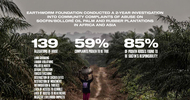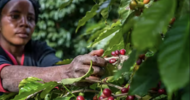Latinamerica Press | 9 September 2014
Peru: Monoculture sweeps Amazon Forests
Ninety percent of the deforestation of Peruvian Amazon forests is due to changing land for agriculture and livestock, ensure experts and environmental groups. Recent reports and journalistic articles revealed that the regional governments of Loreto and Ucayali, in the eastern part of the country, have sold millions of hectares of virgin forests as rural land for African oil palm cultivation.
According to the Peruvian Eco-Development Society (SPDE), “companies with interests and investments in palm oil crops have been acquiring rural land through offers to small farmers to force them to sell their land, through land invasion and through direct negotiation with public employees.”
“The Ministry of Agriculture and Irrigation (MINAGRI) and the regional governments of Loreto and Ucayali continue to promote deforestation to [cultivate] African oil palm by classifying forests as rural lands, by re-classifying forest land for agro-industrial purposes, by authorizing land use changes, and by approving environmental impact studies for agro-industrial projects,” pointed out the SPDE.
According to the MINAGRI, there are 600,000 hectares (1.5 million acres) of land in the Peruvian forest with the potential to grow oil palm crops. Currently, about 60,000 hectares (152,300 acres) are cultivated with this plant, mostly in the Amazonian departments of Huánuco, Loreto, San Martín and Ucayali.
However, Peruvian authorities are not taking into consideration the effects of this business on the environment.
The study “Potential environmental and social impacts of growing oil palm in the department of Loreto,” published in 2012 by the Peruvian Society of Environmental Law (SPDA), states that “the loss of forests associated with the cultivation of oil palm has, evidently, serious impacts on biodiversity. The flora and fauna do not regenerate around plants that replace forests. Additionally, there are risks of contaminating body of waters with agrochemicals and pesticides that are used for agro-industrial operations.”
Agricultural use
In an interview with the SPDA’s news bulletin Actualidad Ambiental, Juan Luis Dammert, one of the study’s authors, explained that “the oil palm plant is a very profitable monoculture crop. It can be an important substitute for the coca leaf crop. Then, it could be produced correctly. However, the issue is not to convert old-growth forests [natural forests, also known as virgin forests, which have not experienced human intervention] into palm monoculture, nor should lands that are classified as forests be used for agriculture.”
According to the SPDA’s investigation, one of the arguments that businessmen and local authorities use to promote this crop is that “the growth of oil palm in the Peruvian Amazon is small compared to the situation in Colombia, Ecuador and Venezuela, where some 300,000, 200,000 and 70,000 hectares [741,000, 494,000 and 173,000 acres], respectively, are estimated to exist.”
According to this logic, “Peru, despite having large stretches of forests, lags behind in terms of oil palm production. Even more, Peru has an oil deficit of about 75 percent, so the development of this crop appears as an issue of national food security,” says the document.
An Aug. 10 report broadcast by Panorama, a program transmitted by Panamericana Televisión, revealed that the Agriculture office of the Regional Government of Ucayali sold the company Plantaciones Ucayali close to 5,000 hectares (13,700 acres) of virgin forests which are considered heritage of the nation. The company paid US$0.04 per square meter of land.
“The decentralization process allows regional governments to sell [land] without asking the buyer for land clearing permits or environmental impact studies that ensure that the agricultural work they do will not affect the ecosystem,” indicated the report.
Peru: Monoculture sweeps Amazon Forests
Ninety percent of the deforestation of Peruvian Amazon forests is due to changing land for agriculture and livestock, ensure experts and environmental groups. Recent reports and journalistic articles revealed that the regional governments of Loreto and Ucayali, in the eastern part of the country, have sold millions of hectares of virgin forests as rural land for African oil palm cultivation.
According to the Peruvian Eco-Development Society (SPDE), “companies with interests and investments in palm oil crops have been acquiring rural land through offers to small farmers to force them to sell their land, through land invasion and through direct negotiation with public employees.”
“The Ministry of Agriculture and Irrigation (MINAGRI) and the regional governments of Loreto and Ucayali continue to promote deforestation to [cultivate] African oil palm by classifying forests as rural lands, by re-classifying forest land for agro-industrial purposes, by authorizing land use changes, and by approving environmental impact studies for agro-industrial projects,” pointed out the SPDE.
According to the MINAGRI, there are 600,000 hectares (1.5 million acres) of land in the Peruvian forest with the potential to grow oil palm crops. Currently, about 60,000 hectares (152,300 acres) are cultivated with this plant, mostly in the Amazonian departments of Huánuco, Loreto, San Martín and Ucayali.
However, Peruvian authorities are not taking into consideration the effects of this business on the environment.
The study “Potential environmental and social impacts of growing oil palm in the department of Loreto,” published in 2012 by the Peruvian Society of Environmental Law (SPDA), states that “the loss of forests associated with the cultivation of oil palm has, evidently, serious impacts on biodiversity. The flora and fauna do not regenerate around plants that replace forests. Additionally, there are risks of contaminating body of waters with agrochemicals and pesticides that are used for agro-industrial operations.”
Agricultural use
In an interview with the SPDA’s news bulletin Actualidad Ambiental, Juan Luis Dammert, one of the study’s authors, explained that “the oil palm plant is a very profitable monoculture crop. It can be an important substitute for the coca leaf crop. Then, it could be produced correctly. However, the issue is not to convert old-growth forests [natural forests, also known as virgin forests, which have not experienced human intervention] into palm monoculture, nor should lands that are classified as forests be used for agriculture.”
According to the SPDA’s investigation, one of the arguments that businessmen and local authorities use to promote this crop is that “the growth of oil palm in the Peruvian Amazon is small compared to the situation in Colombia, Ecuador and Venezuela, where some 300,000, 200,000 and 70,000 hectares [741,000, 494,000 and 173,000 acres], respectively, are estimated to exist.”
According to this logic, “Peru, despite having large stretches of forests, lags behind in terms of oil palm production. Even more, Peru has an oil deficit of about 75 percent, so the development of this crop appears as an issue of national food security,” says the document.
An Aug. 10 report broadcast by Panorama, a program transmitted by Panamericana Televisión, revealed that the Agriculture office of the Regional Government of Ucayali sold the company Plantaciones Ucayali close to 5,000 hectares (13,700 acres) of virgin forests which are considered heritage of the nation. The company paid US$0.04 per square meter of land.
“The decentralization process allows regional governments to sell [land] without asking the buyer for land clearing permits or environmental impact studies that ensure that the agricultural work they do will not affect the ecosystem,” indicated the report.













